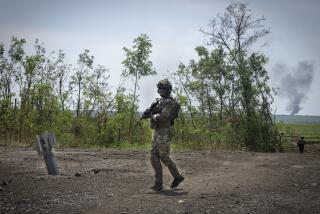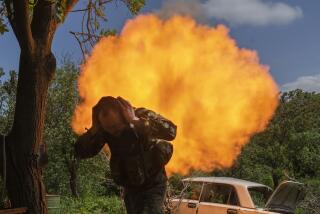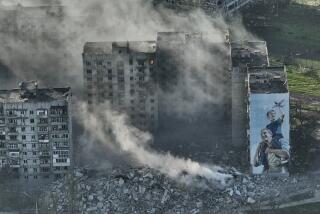Afghan Declares Coalition Victory in High Valley
- Share via
GARDEZ, Afghanistan — A top commander of Afghan forces today declared a total victory in the battle at Shahi Kot, saying Afghan and U.S. troops had occupied the high mountain valley and were in full control on the ground.
“The valley is completely purged,” said Gen. Abdul Wahab Joyendah, military chief of staff for the Afghan zone that includes Shahi Kot. “Just two high points on the snowcapped mountains on the other side of Shahi Kot have remained unexplored,” he said, citing a fresh report that a senior officer brought from the front line this morning.
Joyendah said Afghan troops had discovered documents in Arabic and Chechen along with a number of weapons and that they were being handed over to American forces.
He also said the Americans were in the process of taking away an unknown number of wounded Taliban and Al Qaeda fighters and removing bodies.
“Our Afghan forces are in the valley now, and they are searching and cleansing the entire valley and its caves,” Joyendah said.
Afghan forces entered the valley Tuesday and, according to Afghan and U.S. officials, met with only small pockets of resistance.
On Tuesday, B-52 bombers and U.S. attack helicopters flew over the valley seeking out Al Qaeda and Taliban targets, while on the ground the more than 1,000 newly arrived Afghan troops began inching forward in search of the enemy.
Abdul Hanan, a fighter at a checkpoint in the village of Lakdiwal in eastern Afghanistan, said Tuesday that the Afghan troops had already breached one front line and found several bodies and collapsed caves. The five bodies appeared to include some foreign Al Qaeda fighters, he said.
At least one gun battle took place, according to a radio transmission overheard by reporters. But Al Qaeda and Taliban forces “appear to be in smaller pockets than they were in the early days” of 11-day-old Operation Anaconda, U.S. Army spokesman Maj. Bryan Hilferty said.
Eight Americans died in the first days of the attempt to dislodge the holdouts.
On the flat, dusty plain that leads to one of the entrances to the Shahi Kot valley, trucks moved in the distance. In the morning haze, giant Chinook helicopters could be spotted going to and fro, presumably removing more U.S. troops from the battle area. At one point, they appeared to be ferrying small vehicles into the valley.
Hilferty, speaking Tuesday at Bagram air base north of Kabul, the capital, said about 2,000 troops were in the Shahi Kot valley, with Afghans slightly outnumbering international coalition forces for the first time in the operation.
“I think it always was an ‘Afghanized’ operation,” he said. “The ratio might change, [but] I would tell you, [U.S. troops are] not pulling out.”
In Washington, Air Force Brig. Gen. John W. Rosa Jr. said that although some U.S. troops had been pulled out of the battle, others had moved in, maintaining the number of American forces in the area at the level that it had been for more than a week.
U.S. bombers and fighter jets had dropped more than 100 bombs in the battle zone since Monday, Rosa said, bringing the total to more than 2,500 bombs since the fighting began March 2.
Near the village of Lakdiwal, a Cobra attack helicopter circled overhead and a Sea Stallion helicopter descended to the desert floor in a cloud of brown dust late in the afternoon. Its crew got out and wrestled some sort of heavy bulky object lying on the ground into its hold.
Reporters were kept from solving the mystery by a seemingly mad Afghan sentry in the employ of U.S. forces--a bearded martinet in black ski cap who sometimes flailed a rocket-propelled grenade launcher in their direction, and once cocked his rifle and pointed it toward them, all to get the journalists to drop back 50 paces. After such off-and-on exertions, he would drop down for a rest on a piece of dirty cardboard.
In Gardez, the capital of Paktia province, a spokesman for the shura, or council, said that the newly arrived troops under Gen. Gul Hydar had all been deployed along a hilltop ridge at the edge of the Shahi Kot valley.
In the nearby town of Zormat, a local elder had said Tuesday that proposals were still being floated among Afghans to try to bring about a cease-fire and allow the remaining Al Qaeda and Taliban supporters to quietly leave the valley and go elsewhere.
The town’s deputy security chief, Ghulam Mohammed Farooqi, said Hydar met with the Zormat shura Monday and told the council that if it wanted to send out peace feelers to Mullah Saifur Rahman Mansour, the commander believed to be leading the resistance in the mountains, Hydar would guarantee the holdouts a 10-day halt in the fighting.
The official said that no decision had been made on whether to send a peace mission to Rahman.
U.S. officials had repeatedly said that they would accept only an unconditional surrender.
Farooqi had invited reporters into a small meeting room to voice bitterness at what he characterized as an unjustified arrest last week by U.S. forces of his brother, Mohammed Naim Farooqi, who had been the chief of security in Zormat, on suspicion of cooperating with the Taliban and Al Qaeda forces.
The arrest has generated much ill will in Zormat, a town with strong Taliban ties. Farooqi said emotions have been heightened by the appointment of Afghan commander Abdul Matin as the new security chief in the district as of Tuesday.
Meanwhile, fresh fears for the security of Western journalists prompted several news organizations to leave Paktia on Tuesday.
*
Times staff writers Geoffrey Mohan at Bagram air base and Esther Schrader in Washington contributed to this report.
More to Read
Sign up for Essential California
The most important California stories and recommendations in your inbox every morning.
You may occasionally receive promotional content from the Los Angeles Times.













